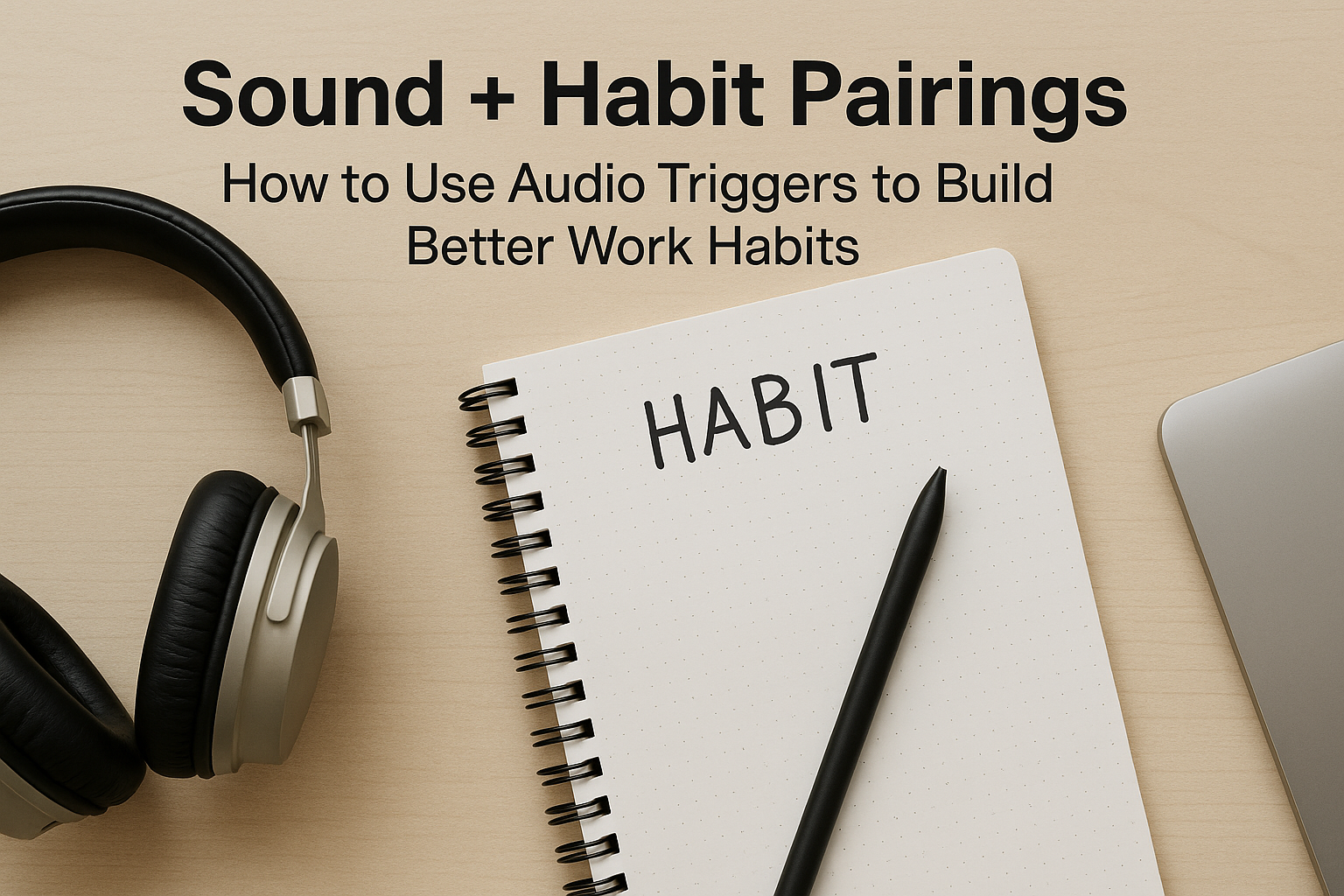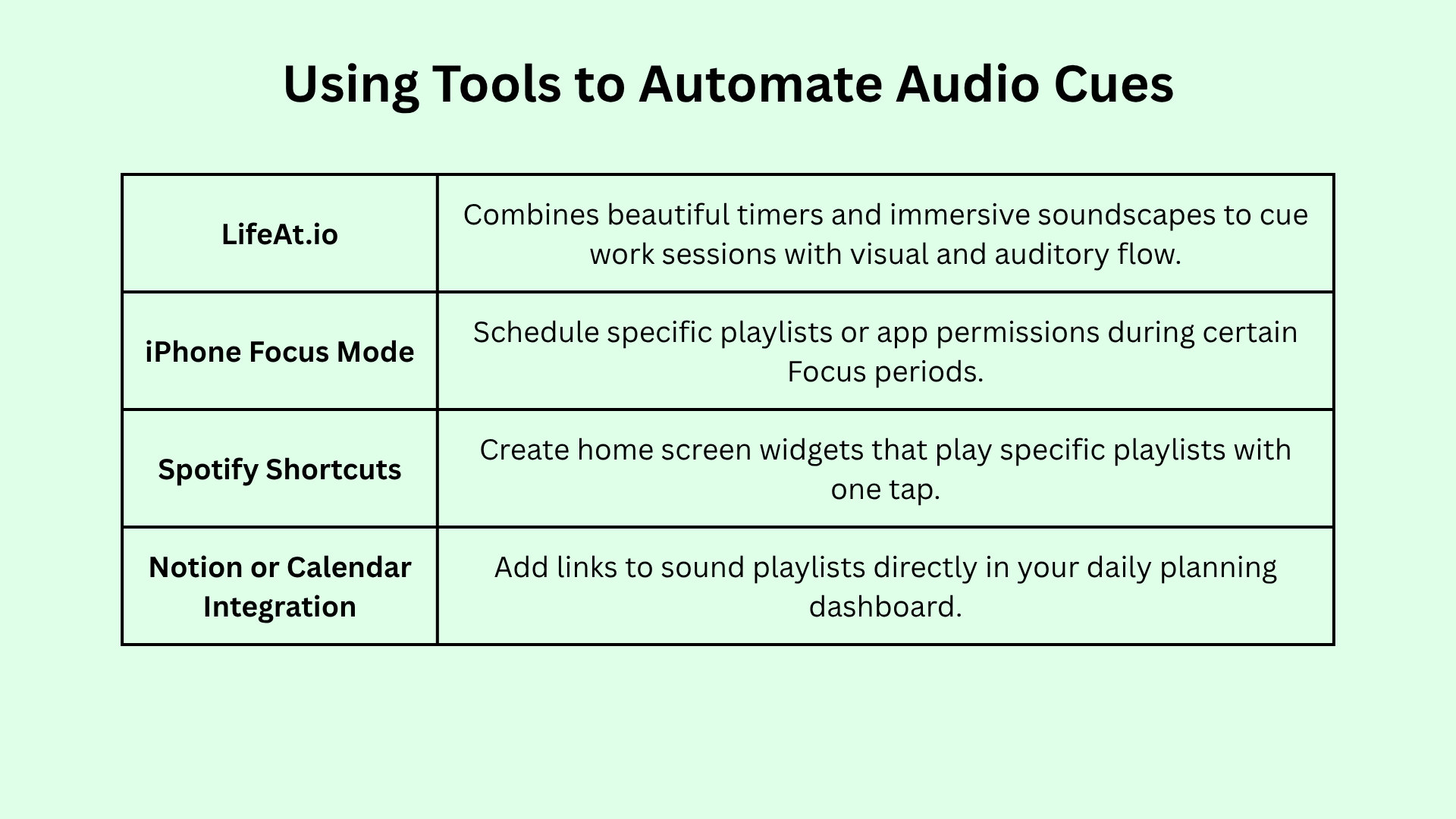We all have that one song that instantly shifts our mood. A notification sound that spikes our stress. A favorite playlist that tells our brain it’s time to start. Sound doesn’t just fill space—it cues behavior.
In productivity science, these moments are known as habit triggers. And when used intentionally, audio triggers—whether a timer chime, a specific focus track, or ambient soundscape—can help you build habits that actually stick.
If you’ve ever struggled to stay consistent with new routines, keep reading. We’re diving into how pairing specific sounds with specific actions can train your brain to shift into focus, reset between tasks, and create structure that feels natural.

Why Sound Works So Well as a Habit Trigger
Your brain is wired to respond to auditory input fast—often faster than visual cues. That’s why hearing a ringtone or an old playlist can bring back memories (or stress responses) almost instantly.
When you repeat an action consistently while hearing the same sound, your brain starts to link the two. It builds a mental shortcut.
Eventually, the sound alone becomes a nudge to take the action. This is the basis of habit stacking—only instead of anchoring your habit to an activity (like brushing your teeth), you’re anchoring it to an auditory cue.
In short: you’re not relying on willpower—you’re relying on rhythm.
How to Pair Sound with Habit (And Make It Stick)
Let’s walk through how to build strong audio-habit associations, from simple triggers to a full work routine.
.png)
1. Choose a Habit You Want to Strengthen
Before picking a sound, define the action you want to build consistently. For example:
- Starting deep work
- Taking a midday reset break
- Transitioning out of work mode
- Winding down your nervous system before bed
Start small. Pick one focus habit and go from there.
2. Pick a Distinct Sound or Song
The key is consistency. Choose a sound that’s specific, repeatable, and not already linked to other tasks. You want it to feel like a ritual, not background noise.
Try:
- The same ambient track every time you begin a Pomodoro sprint
- A chime or tone that marks the start of a writing session
- A playlist that plays only during your 2pm walk or reset
- A focus soundscape with a specific tempo or texture to guide your energy
3. Stack It at the Right Time
Pair the sound with an anchor point—like opening your laptop, lighting a candle, or turning on Focus Mode on your iPhone. These small routines layer together and teach your brain, “This is what we do when this sound plays.”
For example:
- 9:00 AM: Put on noise-canceling headphones → play your "deep work" playlist → start a 45-minute task sprint
- 12:30 PM: Finish a task → cue a light instrumental playlist → prep lunch without scrolling
- 6:00 PM: Power down → play your “off switch” playlist → shift into rest mode
Sound Pairing Ideas for Popular Work Habits
Let’s break down some common habits and how you can use sound to strengthen them:
🔹 Starting Focus Work
Use: Alpha wave soundtracks, lo-fi beats, or brown noise
Habit pairing: Hit play → Start your timer (like a Pomodoro sprint) → Begin the task
Why it works: The repetitive nature of the sound builds mental momentum
🔹 Taking Breaks You’ll Actually Enjoy
Use: Natural soundscapes (birds, rain, ocean) or calming ambient music
Habit pairing: Sound begins → Move away from screen → Stretch, hydrate, or walk
Why it works: Triggers a state shift from “doing” to “resting” without guilt
🔹 Switching Between Task Types
Use: A short chime or a 60-second breathwork track
Habit pairing: Finish one task → Hit play → Use the sound cue to transition
Why it works: Gives your brain a clean slate and reduces carryover stress
🔹 Ending the Workday
Use: Soft instrumental, acoustic, or warm-sounding playlist
Habit pairing: Light a candle → Play the music → Write down tomorrow’s top 3 tasks
Why it works: Reinforces emotional closure and eases your system out of go-mode

Using Tools to Automate Audio Cues
Want to take it even further? You can automate your audio triggers so they run in the background, like a second brain.
- LifeAt.io: Combines beautiful timers and immersive soundscapes to cue work sessions with visual and auditory flow.
- iPhone Focus Mode: Schedule specific playlists or app permissions during certain Focus periods.
- Spotify Shortcuts: Create home screen widgets that play specific playlists with one tap.
- Notion or Calendar Integration: Add links to sound playlists directly in your daily planning dashboard.
Final Thought: Make It a Ritual, Not a Rule
The goal isn’t to turn your day into a playlist of rigid rules. It’s to use sound as a soft structure—a sensory nudge that helps your mind shift states with more ease and less effort.
Think of it like your favorite barista calling your name with your go-to order. The repetition feels familiar. Safe. Grounding.
That’s the power of habit + sound.
So the next time you’re trying to get into focus mode—or out of it—don’t just rely on discipline. Try pressing play.

.png)

.avif)